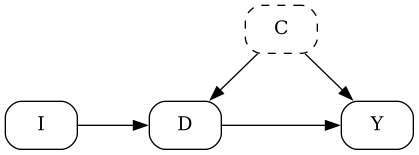chapter nine
9 Instrumental Variables
This chapter covers
- Learning different ways to estimate causal impacts with instrumental variables
- Identifying situations where you can apply instrumental variables
- Learning how to apply instrumental variables with different Python and R packages
you are here
Figure 9.1 Identifying and estimating causal effects with Instrumental Variables

Instrumental Variables (IV) is a technique to estimate causal effects, different from the adjustment formula. It is applicable only in specific scenarios, particularly when your DAG follows the structure in Figure 9.2. Some parts of this DAG are already familiar to us, such as the typical 3-node confounder structure with the decision or treatment variable D, the outcome Y, and the set of confounders C, which we assume is unobserved. Additionally, you might have noticed an extra variable Z, called the instrument, which is a crucial requirement for applying the IV method.
Figure 9.2 Basic Instrumental Variables diagram. Confounders are unobserved. Variable Z plays the role of an instrument.
